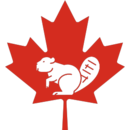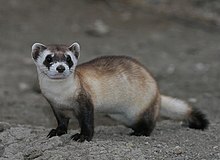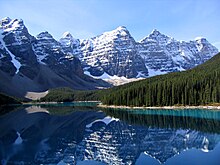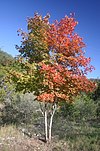Wildlife of Canada: Difference between revisions
→Invasive species: source |
|||
| Line 94: | Line 94: | ||
{{See|List of invasive species in North America|Aquatic invasive species in Canada}} |
{{See|List of invasive species in North America|Aquatic invasive species in Canada}} |
||
Over 1400 [[invasive species]] of fish, plants, insects and invertebrates have been introduced in North America trough intentional and unintentional means.<ref>{{Cite web|url=https://www.thecanadianencyclopedia.ca/en/article/invasive-species-in-canada-animals|title=Invasive Species in Canada: Animals | The Canadian Encyclopedia|website=www.thecanadianencyclopedia.ca}}</ref> The [[Great Lakes region]] is home to nearly 200 invasive species, one of Canada’s most heavily affected ecosystems.<ref>{{Cite web|url=https://www.theweathernetwork.com/ca/news/article/the-invasive-species-threatening-canada-biodiversity-you-may-not-know-about-giant-hogweed-dog-strangling-vine-purple-loosestrife|title=The invasive species threatening Canada’s biodiversity you may not know about|first=Pelmorex Weather Networks|last=Inc|website=www.theweathernetwork.com}}</ref> The most invasive funa are the [[Sea lamprey]], [[Zebra mussels]], [[European green crab]], the [[Mountain pine beetle]], [[Round goby]], [[Asian long-horned beetle]], [[Emerald ash borer]], [[Didymo]], [[Gypsy moth]], and [[Asian carp]] have alter local habitats and cause essential ecosystem to decline or fail.<ref name="LeeService2004"/> These species also threaten native species at risk of extinction.<ref>{{Cite journal|author=Dextrase, Alan|author2=Mandrak, Nicholas|title=Impacts of Alien Invasive Species on Freshwater Fauna at Risk in Canada|journal=Biological Invasions|date=2006-01-01|publisher=Springer Netherlands|issn=1387-3547|pages=13–24|volume=8|issue=1|doi=10.1007/s10530-005-0232-2}}</ref> The most invasive flora species are the [[Purple loosestrife]], [[Yellow iris]], [[Dog-strangling vine]], [[Knapweed]], [[leafy spurge]] and the fungi [[Dutch elm disease]].<ref name="LeeService2004"/> These species can grow aggressively, outcompete native wild vegetation and overwhelm agricultural crops.<ref name="LeeService2004">{{cite book|author1=Michelle Lee|author2=Canadian Wildlife Service|title=Invasive Alien Species in Canada|url=https://books.google.com/books?id=4J-kMHC-irkC|year=2004|publisher=Canadian Wildlife Service|isbn=978-0-662-34262-5}}</ref> According to [[Environment and Climate Change Canada]], in 2004 the estimated annual lost revenue caused by the top 16 invasive species was between $13 to $35 billion.<ref name=Council>{{Cite web|url=https://canadainvasives.ca/invasive-species/|title=Invasive species|publisher=Canadian Council on Invasive Species|year=2017}}</ref> With the economic cost on just agriculture crops and forestry estimated at $7.5 billion.<ref name=Council/>{{-}} |
Over 1400 [[invasive species]] of fish, plants, insects and invertebrates have been introduced in North America trough intentional and unintentional means.<ref>{{Cite web|url=https://www.thecanadianencyclopedia.ca/en/article/invasive-species-in-canada-animals|title=Invasive Species in Canada: Animals | The Canadian Encyclopedia|website=www.thecanadianencyclopedia.ca}}</ref> There are over 450 invasive flora and over 400 invasive insect that have been identified in Canada.<ref name="SchlichterMontes2011">{{cite book|author1=Tomás Schlichter|author2=Leopoldo Montes|title=Forests in Development: A Vital Balance|url=https://books.google.com/books?id=rE-YG8S46mkC&pg=PA34|year=2011|publisher=Springer Science & Business Media|isbn=978-94-007-2576-8|page=34}}</ref> The [[Great Lakes region]] is home to nearly 200 invasive species, one of Canada’s most heavily affected ecosystems.<ref>{{Cite web|url=https://www.theweathernetwork.com/ca/news/article/the-invasive-species-threatening-canada-biodiversity-you-may-not-know-about-giant-hogweed-dog-strangling-vine-purple-loosestrife|title=The invasive species threatening Canada’s biodiversity you may not know about|first=Pelmorex Weather Networks|last=Inc|website=www.theweathernetwork.com}}</ref> The most invasive funa are the [[Sea lamprey]], [[Zebra mussels]], [[European green crab]], the [[Mountain pine beetle]], [[Round goby]], [[Asian long-horned beetle]], [[Emerald ash borer]], [[Didymo]], [[Gypsy moth]], and [[Asian carp]] have alter local habitats and cause essential ecosystem to decline or fail.<ref name="LeeService2004"/> These species also threaten native species at risk of extinction.<ref>{{Cite journal|author=Dextrase, Alan|author2=Mandrak, Nicholas|title=Impacts of Alien Invasive Species on Freshwater Fauna at Risk in Canada|journal=Biological Invasions|date=2006-01-01|publisher=Springer Netherlands|issn=1387-3547|pages=13–24|volume=8|issue=1|doi=10.1007/s10530-005-0232-2}}</ref> The most invasive flora species are the [[Purple loosestrife]], [[Yellow iris]], [[Dog-strangling vine]], [[Knapweed]], [[leafy spurge]] and the fungi [[Dutch elm disease]].<ref name="LeeService2004"/> These species can grow aggressively, outcompete native wild vegetation and overwhelm agricultural crops.<ref name="LeeService2004">{{cite book|author1=Michelle Lee|author2=Canadian Wildlife Service|title=Invasive Alien Species in Canada|url=https://books.google.com/books?id=4J-kMHC-irkC|year=2004|publisher=Canadian Wildlife Service|isbn=978-0-662-34262-5}}</ref> According to [[Environment and Climate Change Canada]], in 2004 the estimated annual lost revenue caused by the top 16 invasive species was between $13 to $35 billion.<ref name=Council>{{Cite web|url=https://canadainvasives.ca/invasive-species/|title=Invasive species|publisher=Canadian Council on Invasive Species|year=2017}}</ref> With the economic cost on just agriculture crops and forestry estimated at $7.5 billion.<ref name=Council/>{{-}} |
||
== Conservation == |
== Conservation == |
||
Revision as of 05:30, 29 December 2020
| Part of a series on |
| Canadian wildlife |
|---|
 |
The wildlife of Canada or biodiversity of Canada consist of over 80,000 classified species, with an equal number yet to be recognized or discovered.[a] Canadian fauna and Canadian flora species are divided among five different kingdoms:[2] protozoa (approximately 1% of recorded species); chromist (approximately 4% of recorded species); fungis (approximately 16% of recorded species); plants (approximately 11% of recorded species); and animals (approximately 68% of recorded species).[1] Insects account for nearly 70 percent of recored animal species in Canada.[1]
Canada is divided into fifteen terrestrial and five marine ecozones.[3] The largest marine ecozone is the Arctic Archipelago whereas the terrestrial ecozone is the Boreal Shield.[4] The main biomes of Canada are tundra, boreal forest, mixed forest, broadleaf forest, prairies, Rocky Mountains, and temperate coniferous forests. Since the end of the last glacial period, Canada has consisted of eight distinct forest regions,[5] with 42 percent of its land area covered by forests (approximately 8 percent of the world's forested land),[6]
Due to human activities, invasive species and environmental issues in the country, there are currently more than 800 species at risk of being lost.[7] About 65 percent of Canada’s resident species are considered "Secure".[2] Protected areas of Canada and National Wildlife Areas have benn established to preserve and restore Canadian flora and fauna. Approximately 5000 Canadian animal species and 30,000 Canadian plant species are restricted from export for intrenatinal trade.[8]
Fauna

There are approximately 200 mammal species, over 460 native bird species, 43 amphibian species, 43 reptile species, and 1,200 fish species in Canada.[9][10] The biology survey of Canada also cites that there are approximately 55,000 species of insects, and 11,000 species of mites and spiders.[11] Canada is known for its mammals such as American bison, Arctic hare, badger, beaver, black bear, bobcat, little brown bat, Canada lynx, caribou, coyote, grizzly bears, wolf, red fox, lemming, meadow mice, moose, mountain lion, mule deer, musk ox, muskrat, polar bear, prairie dog, pronghorn, raccoon, pinniped (seal), skunk, snowshoe hare, walrus, white tailed deer, wolverine.[12] To name a few of the birds identified with Canada would be the American robin, Bicknell's thrush, black-capped chickadee, blue jay, burrowing owl, Canada goose, canvasback, downy woodpecker, Canada jay, great blue heron, great horned owl, greater snow goose, killdeer, loons, piping plover, purple martin, ruby-throated hummingbird, sharp-shinned hawk, Cooper's hawk, and whooping crane.[13]
Flora

According to environment Canada the nation hosts approximately 17,000 identified species of trees, flowers, herbs, ferns, mosses and other flora.[14] Some trees native to Canada are black spruce, white spruce, balsam fir, larch, lodgepole pine, jack pine, cottonwood and white birch, and balsam poplar.[15] Approximately half of Canada is covered by forest, totaling around 2.4 million km2 (0.93 million sq mi).[16] Over 90% of Canada's forests are owned by the public (Crown land and the majority being Provincial forests).[17] About half of the forests are allocated for logging.[18] Native plants include; American Ginseng, Trillium cernuum, Red Bearberry, Bog Labrador Tea, Purple prairie clover, Sand cherry, Pallas' wallflower, Little evening primrose, Showy orchis and Common eelgrass.[19]
Species at risk

Canada's Species at Risk Act (SARA) is the federal government legislation to prevent wildlife species from becoming extinct. Due to pollution, loss of biodiversity, over-exploitation of commercial species and habitat loss more then 800 wild life species are listed as being at risk of extinction; including 363 classified as endangered species, —190 threatened species, —235 special concern, and 22 extirpated (no longer found in the wild).[7] More than 30 species have become extinct since the arrival of European settlers in the 16th century,[20] including; the Dawson's caribou, Sea mink, Great auk, Labrador duck, Passenger pigeon, Deepwater cisco, Longjaw cisco, Banff longnose dace, and Blue walleye.[21]
Invasive species

Over 1400 invasive species of fish, plants, insects and invertebrates have been introduced in North America trough intentional and unintentional means.[22] There are over 450 invasive flora and over 400 invasive insect that have been identified in Canada.[23] The Great Lakes region is home to nearly 200 invasive species, one of Canada’s most heavily affected ecosystems.[24] The most invasive funa are the Sea lamprey, Zebra mussels, European green crab, the Mountain pine beetle, Round goby, Asian long-horned beetle, Emerald ash borer, Didymo, Gypsy moth, and Asian carp have alter local habitats and cause essential ecosystem to decline or fail.[25] These species also threaten native species at risk of extinction.[26] The most invasive flora species are the Purple loosestrife, Yellow iris, Dog-strangling vine, Knapweed, leafy spurge and the fungi Dutch elm disease.[25] These species can grow aggressively, outcompete native wild vegetation and overwhelm agricultural crops.[25] According to Environment and Climate Change Canada, in 2004 the estimated annual lost revenue caused by the top 16 invasive species was between $13 to $35 billion.[27] With the economic cost on just agriculture crops and forestry estimated at $7.5 billion.[27]
Conservation

Approximately 11.5 percent of the nation’s landmass and 1.3 percent of its territorial waters are protected areas intended to preserve ecological integrity.[28] Conservation areas have different classifications of protection, depending on the organization which manages them with some protected areas having a greater focus on ecological integrity than others.[29] The primary focus of national parks is to preserve ecological integrity.[30] These parks are administered by Parks Canada. National Marine Conservation Areas, while also under federal control, do not afford the same level of protection.[31] The Canadian Wildlife Service, a division of Environment Canada, manages the National Wildlife Areas, Marine Wildlife Areas, and Migratory Bird Sanctuaries for the protection of wildlife.[32][33] Canada's first National Park, Banff National Park established in 1885, spans 6,641 square kilometres (2,564 sq mi)[34] of mountainous terrain, with many glaciers and ice fields, dense coniferous forest, and alpine landscapes.[35] The largest national wildlife area is the Scott Islands Marine National Wildlife Area, which covers an area of 11,570.65 km2 (4,467.45 sq mi)[36] protects critical breeding and nesting habitat for over 40 percent of British Columbia's seabirds.[37]
National wildlife symbols
Canada does not have a floral emblem at the national level.[38]
| Symbol | Image | Notes |
|---|---|---|
| National flag[39] | 
|
Official symbol as of February 15, 1965[39] |
| National tree[39] |  Maple |
Official symbol since 1996[39] |
| Maple leaf[40] |  Maple leaf |
De facto symbol since 1700s[40] |
| National animals[39] |  Beaver |
Official symbol since 1975[39] |
 Canadian horse |
Official symbol since 2002[39] |
Provincial wildlife symbols
See also
- Overlapping ecosystems
- Fauna of the United States
- Flora of the United States
- Invasive species in the United States
- Asian carp in North America
Notes-
References
- ^ a b c "Wild Species 2015: The General Status of Species in Canada" (PDF). National General Status Working Group: 1. Canadian Endangered Species Conservation Council. 2016. p. 2.
- ^ a b "Wild Species 2000: The General Status of Species in Canada". Minister of Public Works and Government Services Canada. Conservation Council (CESCC). 2001.
- ^ Government of Canada, Statistics Canada (2018-01-10). "Introduction to the Ecological Land Classification (ELC) 2017". www.statcan.gc.ca. Retrieved 2020-11-09.
- ^ Wiken, Ed. "Casting the bottom line on the blue planet". Natural Resources Canada. Archived from the original on 2008-06-12. Retrieved 2008-02-13.
- ^ National Atlas of Canada. Natural Resources Canada. 2005. p. 1. ISBN 978-0-7705-1198-2.
- ^ Luckert, Martin K.; Haley, David; Hoberg, George (2012). Policies for Sustainably Managing Canada's Forests: Tenure, Stumpage Fees, and Forest Practices. UBC Press. p. 1. ISBN 978-0-7748-2069-1.
- ^ a b "COSEWIC Annual Report". Species at Risk Public Registry. 2019.
- ^ Canada, Environment and Climate Change (May 19, 2017). "Endangered species list". aem.
- ^ "Canada Animals | Canadian Animals | Canada Wildlife | AZ Animals". A-Z Animals.
- ^ "Animals". Mammals, Birds, Marine Life and Insects of Canada. Proud Canadian Kids. Archived from the original on 2008-07-03. Retrieved 2008-11-07.
- ^ "Biological Survey of Canada (Terrestrial Arthropods)". Canadian Museum of Nature. 2006–2008. Retrieved 2008-11-07.
- ^ "CANADIAN ANIMALS - food, enemies, adaptations, homes". Saskatchewan Schools. 2006–2008. Archived from the original on 2008-11-02. Retrieved 2008-11-07.
- ^ "Hinterland Who's Who - Bird Fact Sheets". Canadian Wildlife Service & Canadian Wildlife Federation. 2008. Archived from the original on 2008-11-11. Retrieved 2008-11-07.
- ^ "Environment Canada - Nature - Flora". Government of Canada. 2007-03-20. Retrieved 2008-11-07.
- ^ "Canada's Boreal Forest, Forest Products Association of Canada, map, inside front cover.
- ^ "Total forest coverage by country". the Guardian. 2 September 2009. Retrieved 23 September 2018.
- ^ Canada, Natural Resources (May 25, 2015). "Forest land ownership". www.nrcan.gc.ca.
- ^ Graham Duggan (2018). "The World's Biggest Forest Is In Our Own Backyard And We Need To Protect It". The Nature of Things (CBC).
- ^ "Native Plant Encyclopedia". cwf-fcf.org.
- ^ "Species at Risk in Canada". Hinterland Who's Who. 2010.
- ^ "Hinterland Who's Who - Biodiversity". Canadian Wildlife Federation.
- ^ "Invasive Species in Canada: Animals | The Canadian Encyclopedia". www.thecanadianencyclopedia.ca.
- ^ Tomás Schlichter; Leopoldo Montes (2011). Forests in Development: A Vital Balance. Springer Science & Business Media. p. 34. ISBN 978-94-007-2576-8.
- ^ Inc, Pelmorex Weather Networks. "The invasive species threatening Canada's biodiversity you may not know about". www.theweathernetwork.com.
{{cite web}}:|last=has generic name (help) - ^ a b c Michelle Lee; Canadian Wildlife Service (2004). Invasive Alien Species in Canada. Canadian Wildlife Service. ISBN 978-0-662-34262-5.
- ^ Dextrase, Alan; Mandrak, Nicholas (2006-01-01). "Impacts of Alien Invasive Species on Freshwater Fauna at Risk in Canada". Biological Invasions. 8 (1). Springer Netherlands: 13–24. doi:10.1007/s10530-005-0232-2. ISSN 1387-3547.
- ^ a b "Invasive species". Canadian Council on Invasive Species. 2017.
- ^ "Infographic: Canada's protected areas". The Royal Canadian Geographical Society. February 2, 2017.
- ^ "Protected Areas". The Canadian Encyclopedia. 2014.
- ^ Canada. Parliament. House of Commons (November 2004). House of Commons Debates. p. 1830.
- ^ "Consolidated federal laws of canada, Canada National Marine Conservation Areas Act". Legislative Services. Government of Canada. August 28, 2019.
- ^ J. Alexander Burnett (2011). A Passion for Wildlife: The History of the Canadian Wildlife Service. UBC Press. p. 170. ISBN 978-0-7748-4252-5.
- ^ "Environment Canada's Protected Areas Network". Hinterland Who's Who. Canadian Wildlife Service. Retrieved 2019-03-14.
- ^ "The Mountain Guide – Banff National Park" (PDF). Parks Canada. 2006. Archived from the original (PDF) on June 15, 2006.
- ^ Martin F. Price (2013). Mountain Area Research and Management: Integrated Approaches. Earthscan. pp. 217–218. ISBN 978-1-84977-201-3.
- ^ "Scott Islands Marine National Widllife Area". Protected Planet. Retrieved 2020-09-25.
- ^ Canada, Environment and Climate Change (February 7, 2013). "Proposed Scott Islands Marine National Wildlife Area: regulatory strategy". aem.
- ^ "Floral Emblems of Canada – A Bouquet". Canadian Heritage. 21 March 2009. Archived from the original on 30 May 2013. Retrieved 2013-04-03.
- ^ a b c d e f g "Official symbols of Canada". Government of Canada. 2017.
- ^ a b "Unofficial symbols of Canada". The Department of Canadian Heritage. Retrieved 2019-01-01.
- ^ "Government of Alberta's official emblems". Archived from the original on 2009-06-26. Retrieved 2008-11-07.
- ^ "Government of British Columbia's official emblems". Archived from the original on 2008-12-04. Retrieved 2008-11-07.
- ^ "British Columbia - Symbols of BC - BritishColumbia.com". Shangaan Webservices Inc. 1998–2006. Retrieved 2008-11-07.
- ^ "Symbols of British Columbia - Protocol and Events Branch". Province of British Columbia. 2007. Archived from the original on 2016-01-16. Retrieved 2008-11-07.
- ^ "Government of Manitoba's official emblems". Archived from the original on 2008-09-25. Retrieved 2008-11-07.
- ^ "Manitoba Symbols: A Complete Reference (GeoSymbols)". Archived from the original on 2008-10-12. Retrieved 2008-11-07.
- ^ "Government of Newfoundland and Labrador's official emblems". Archived from the original on 2009-01-02.
- ^ Heritage, Canadian (2017-08-15). "Nova Scotia". aem. Retrieved 2020-04-17.
- ^ "Ontario's provincial symbols". Department of Canadian Heritage. Retrieved 6 February 2020.
- ^ Heritage, Canadian (2017-08-15). "Prince Edward Island". aem. Retrieved 2020-04-17.
- ^ "Find out about Yukon's symbols and emblems". Government of Yukon. 30 May 2019. Retrieved 2020-02-06.
Further reading
- Stephen Bocking (2000). Biodiversity in Canada: Ecology, Ideas, and Action. Broadview Press. ISBN 978-1-55111-238-1.
- Jamie Benidickson (2020). Environmental Law in Canada. Wolters Kluwer. ISBN 978-94-035-1895-4.
- Max Foran (2018). The Subjugation of Canadian Wildlife: Failures of Principle and Policy. McGill-Queen's University Press. ISBN 978-0-7735-5428-3.
- C. Tyler DesRoches; Frank Jankunis; Byron Williston (2019). Canadian Environmental Philosophy. McGill-Queen's University Press. ISBN 978-0-7735-5777-2.
External links
- Wildlife, plants and species ~ Government of Canada
- Species at Risk Public Registry A to Z Species Index








